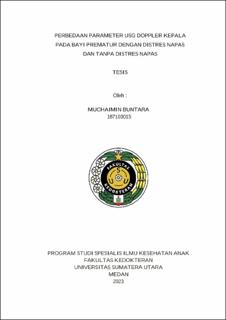| dc.description.abstract | Background: Cerebral blood flow (CBF) involves complex nervous and metabolic mechanisms in premature newborns. Failure of autoregulation increases the risk of brain injury and persistent neurologic disability in premature infants who experience respiratory distress due to vascular immaturity in the germinal matrix of the brain and lungs immaturity. Doppler ultrasound (USG) is a useful tool for monitoring the autoregulation of cerebral blood flow.
Objective: To determine the differences in the parameters of transcranial Doppler ultrasound in premature infants with respiratory distress and without respiratory distress.
Methods: This cross-sectional analytic study was carried out in the NICU and perinatology ward of H. Adam Malik General Hospital, Medan. Basic data and results of transcranial Doppler ultrasound parameters were taken from medical records from January 2019 - January 2022. Parameter assessment included peak systolic velocity (PSV), end diastolic velocity (EDV), mean velocity (MV), resistive index (RI), and pulse amplitude index (PI) as assessed from the anterior cerebral artery (ACA) and medial cerebral artery (MCA).
Results37 premature infants with respiratory distress and 37 premature infants without respiratory distress met the inclusion and exclusion criteria. The results showed that the mean ultrasound parameters for ACA in premature infants with respiratory distress were compared to those without respiratory distress, namely PSV 33.73 vs. 35.28 (p = 0.627), EDV 8.4 vs. 8.12 (p = 0.718), MV 16.18 vs. 16.84 (p = 0.492), PI 1.61 vs. 1.64 (p = 0.390), and RI 0.74 vs. 0.76 (p =Meanwhile, the results of the mean ultrasound parameters on MCA were PSV 38.72 vs. 40.47 (p = 0.173), EDV 9.93 vs. 10.43 (p = 0.574), MV 17.38 vs. 18.04 (p = 0.515), PI 1.66 vs. 1.66 (p = 0.607), and RI 0.74 vs. 0.736 (p = 0.600). Based on statistical tests, the T-test and Mann-Whitney U tests showed insignificant results for transcranial ultrasound parameters in both variables.
Conclusion: There is no difference in transcranial Doppler ultrasound parameters in premature infants with respiratory distress compared to those without respiratory distress. | en_US |




